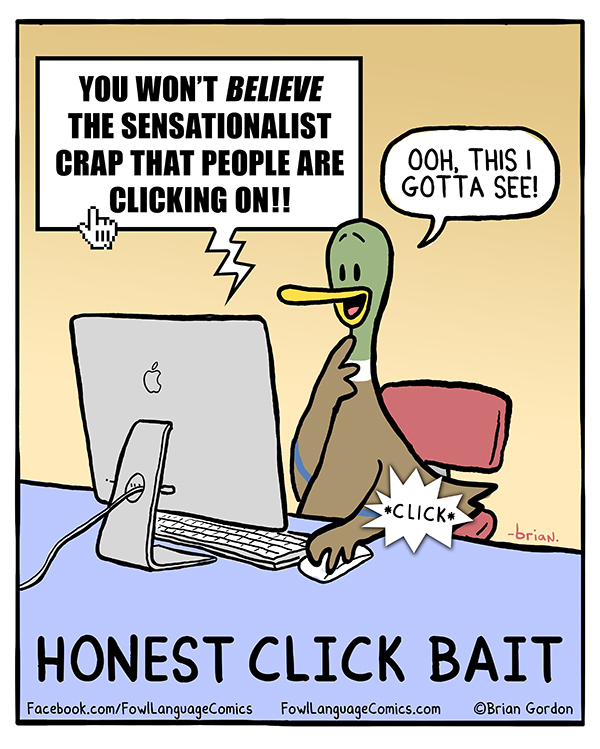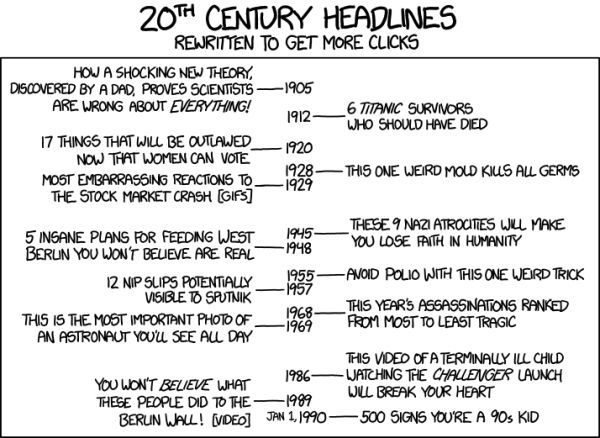Facebook recently announced changes to the newsfeed algorithm intended to curb link-bait type headlines. This is how they define link-bait:
“Click-baiting” is when a publisher posts a link with a headline that encourages people to click to see more, without telling them much information about what they will see.”
One way they suggested that they would help do this was to check how long people spend away from Facebook. This is interesting as social referral and engagement leaders Buzzfeed also track ‘time on page’ as one of their key metrics to determine article quality.

Giving more weighting and relevance in the Facebook newsfeed to articles that send people away for longer might seem counterintuitive – after all why would Facebook want to send you away at all? However it’s another example of a forward thinking company embracing people’s behaviour rather than denying it or trying to change it. The fact is, more and more, people are using Facebook as a portal – consuming news and interesting articles from the social media platform. The inherent bonus of Facebook is that this content is curated once by your own group of friends – so you trust that it’s not just nonsense.
If the articles you find yourself seeing and clicking on on Facebook are consistently of poor quality or low value, eventually it will reflect on Facebook. Look at the ‘save link’ option too – this allows people to ‘bookmark’ links they see in posts should they not have the time to read them when they see them. With the algorithm changes, in theory you should see higher quality articles more often in your news feed. When you do click through, you’re likely to click on further articles if the website hosts stories that are interesting (and relevant to you).
See this unexpected bit of information from hubspot.
“[there is] no relationship whatsoever between the amount a piece of content is shared and the amount of attention an average reader will give that content.”
So basically, people share rubbish because they can’t even be bothered to read the articles – they just see it being shared and assume it will be useful to someone. The more shares, the more clicks, the more clicks, the more irritated users on Facebook.
So for the Facebook user, this change is good news. For media companies this is also good news. For companies that rely on clickbait style links, this is bad. It doesn’t mean that Facebook is clearing up unworthy articles as much as it’s sweeping away so many ‘upworthy’ articles. If you want to gorge on lightweight celeb news, there’s plenty of room for that, but it doesn’t need to be actively sneaky or misleading.

The “Links as links” change.
Regarding Facebook’s other change, here’s what they have to say:
“We’ve found that people often prefer to click on links that are displayed in the link format (which appears when you paste a link while drafting a post), rather than links that are buried in photo captions.”
That’s true, and even though it goes against previous advice we’ve given, we approve. In the past – brands were more likely to get engagement on the post (and thus higher visibility & more clickthroughs) if it was posted as a photo with a link buried in the text. One reason for this is that for links to display properly to the user, the metadata/tags must point to the correct image. When this doesn’t happen, links can be rendered with tiny thumbnail pictures which are swept past much more frequently during regular Facebook browsing.
Interestingly, Facebook mention:
“In our studies, these posts have received twice as many clicks compared to links embedded in photo captions.”
If I was to guess a reason for this – it would be that the busiest and most popular media companies tend to post 10-20 stories on Facebook per day, so they post them as links. Posting these as a link is trivial. Sourcing a relevant photo and typing a headline that tells something about the article is considerably more resource intensive. For a smaller site posting 3-4 times a day, it’s possible, but 15-20? Very difficult. Therefore, the majority of traffic and clicks are coming from media companies that post links. Regardless of the reason though, this means less hassle for brands and a slightly better option for consumers.
Finally, from Facebook:
“We’re making these changes to ensure that click-bait content does not drown out the things that people really want to see on Facebook.”
Hooray! It sounds obvious, but Facebook want you to have a good time and see good content that you like while you’re on Facebook. They are constantly tweaking things to ensure that you as a user see relevant stories in your news feed.
The more rubbish you see clogging up your Facebook feed, the chances and frequency of you returning to the site decreases. It’s absolutely in Facebook’s interest to keep you there, keep you occupied and hide low quality content that annoys you.
